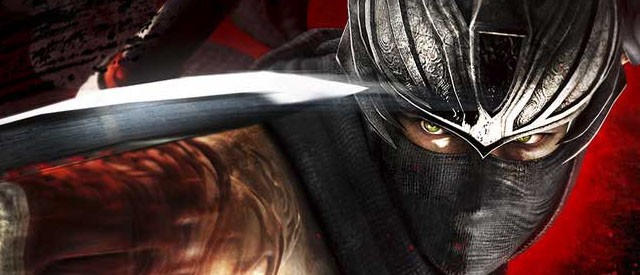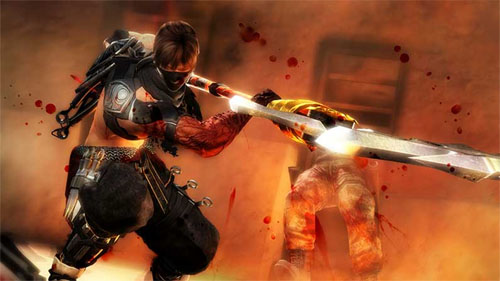

Ninja Gaiden 3: Razor’s Edge (henceforth Razor’s Edge) was originally an enhanced Wii U port of the original Ninja Gaiden 3, complete with all the DLC and additional enhancements. The Razor’s Edge that came out last week (and the version this review is about) was the port of that game to the PS3 and 360. So I guess it’s a port of an enhanced port of the original game. Confusing, but there we have it.
There are three main categories of gameplay offered for Razor’s Edge: Story mode (single-player), Chapter Challenge (single-player, unlocked later), and Shadows of the World (online multiplayer and co-op, co-op unlocked later). All of these modes share the same gameplay mechanics, so let’s talk about those first.

You'll be seeing close-up shots of finishing off enemies over... and over... and over...
Combat is probably what one would expect from a Ninja Gaiden game. Mobility and blocking are key, and there are long and complicated combos of strong and weak attacks players can string together for some pretty cool effects. There are multiple weapon types that players can switch between (e.g. claw vs. katana) and multiple ninpos (powerful abilities that need to be charged up). Levels consist of different stages where all the enemies need to be vanquished, and then the player will receive a time and health grade, which converts into a “karma” point system. These points can be spent on new techniques, costumes, rank-ups, etc.
Though this all sounds pretty neat on paper, in practice I wasn’t too blown away by the combat. I’d consider myself a fan of third-person action games and I’ve been impressed by the Ninja Gaiden games I’ve played in the past. Razor’s Edge just didn’t grab me like those other games, and a lot of that had to do with the combat. Finishing off an enemy with a strong attack causes the camera to zoom in for a close up of the gory death, which sounds fine; however, since I often found myself finishing off several enemies in a row, I was treated to a repeated zooming in and out of the camera. This got old really fast.
Quick time events are also quite prevalent, especially during boss fights. The quick time events weren’t integrated in an innovative way and felt a little tacked on. Last, though Razor’s Edge allows players to play as four different characters, none of the characters really felt different enough for me to feel very excited about getting to play a new one. They had different animations for sure, and I’m sure there are nuances to their combos which make them different from each other, but as a casual player it didn’t feel like enough to make unlocking them an exciting experience.
Okay, so we got my gripes about the combat out of the way. What about the co-op? The co-op mode for Razor’s Edge is called Ninja Trials, and is unlocked after the second chapter of the Story Mode. It’s two-player online co-op only, and you can quick join a random lobby, create a lobby of your own, search for lobbies, or invite a friend to play. A total of 25 maps are provided (pulled straight from the story mode levels), and each trial consists of a few waves of mobs the players will have to vanquish, then a boss fight at the end. Players can resurrect each other if someone becomes incapacitated. Everyone will start on “acolyte” difficulty, but completing maps will unlock “mentor” and “leader” difficulties for an increased challenge.
You, too, can dress up Ayane in her weird stripper outfit, complete with butterfly bra!
Everyone will start off in Ninja Trials only being able to play as an “unknown ninja” that you can customize. As you progress through the story mode, however, additional characters will become unlocked (Ayane, Momiji, Kasumi, and Ryu). You’ll only be able to get levels and karma for your unknown ninja while playing Ninja Trials, however. If you play as any of the story characters, they won’t receive levels or karma, but there are costume unlocks for completing a certain amount of maps on the different story characters. If you want to unlock upgrades or levels for these story characters, however, you’ll have to play the single-player Chapter Challenge on the character you want to progress.
I played several maps with random people, but I can’t say I found it to be very riveting. Though a full map only took 5-10 minutes depending on if we had to retry from a checkpoint (you get 5 retries for a map), I could only do one or two before I had to stop. Ninja Trials is all about the combat, and as I pointed out before, I wasn’t really sold on Razor’s Edge’s combat. If you’re a die-hard fan of Ninja Gaiden and you have another friend who is also a die-hard fan that you can play with online, you two could probably spend maybe half an hour at a time enjoying it, but sad to say that it’s very difficult to recommend Razor’s Edge solely on its co-op content. I also find it really weird that players can’t level up their story characters in Ninja Trials and are forced to go to a single-player mode to progress them, then take them back to the Ninja Trials to play.
I really don't know what to say about Kasumi's outfit here...
All in all, Razor’s Edge certainly isn’t a bad game, but I personally found it to be a pretty mediocre one, bordering on disappointing. I just never found myself “wowed,” and I wanted to be. I do have to say, however, I appreciated that I was given the option to play the game in its original Japanese audio complete with subtitles. If you buy the game for the story mode, the co-op mode may be a nice bonus, but it’s certainly not a reason to buy the game. There is simply not enough that the Ninja Trials mode has to offer for all but the most die-hard fans.
The Co-Optimus review of Ninja Gaiden 3: Razor’s Edge is based on the PS3 version of the game. A copy of the game was provided by the publisher for review purposes.